An hpr1 point mutation that impairs transcription and mRNP biogenesis without increasing recombination
- PMID: 16908536
- PMCID: PMC1636866
- DOI: 10.1128/MCB.00684-06
An hpr1 point mutation that impairs transcription and mRNP biogenesis without increasing recombination
Abstract
THO/TREX, a conserved eukaryotic protein complex, is a key player at the interface between transcription and mRNP metabolism. The lack of a functional THO complex impairs transcription, leads to transcription-dependent hyperrecombination, causes mRNA export defects and fast mRNA decay, and retards replication fork progression in a transcription-dependent manner. To get more insight into the interconnection between mRNP biogenesis and genomic instability, we searched for HPR1 mutations that differentially affect gene expression and recombination. We isolated mutants that were barely affected in gene expression but exhibited a hyperrecombination phenotype. In addition, we isolated a mutant, hpr1-101, with a strong defect in transcription, as observed for lacZ, and a general defect in mRNA export that did not display a relevant hyperrecombination phenotype. In THO single-null mutants, but not in the hpr1 point mutants studied, THO and its subunits were unstable. Interestingly, in contrast to hyperrecombinant null mutants, hpr1-101 did not cause retardation of replication fork progression. Transcription and mRNP biogenesis can therefore be impaired by THO/TREX dysfunction without increasing recombination, suggesting that it is possible to separate the mechanism(s) responsible for mRNA biogenesis defects from the further step of triggering transcription-dependent recombination.
Figures
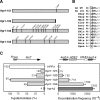



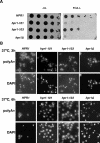
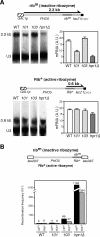
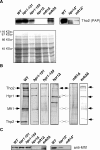
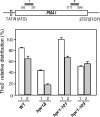
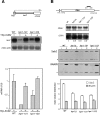

Similar articles
-
Replication fork progression is impaired by transcription in hyperrecombinant yeast cells lacking a functional THO complex.Mol Cell Biol. 2006 Apr;26(8):3327-34. doi: 10.1128/MCB.26.8.3327-3334.2006. Mol Cell Biol. 2006. PMID: 16581804 Free PMC article.
-
Tho1, a novel hnRNP, and Sub2 provide alternative pathways for mRNP biogenesis in yeast THO mutants.Mol Cell Biol. 2006 Jun;26(12):4387-98. doi: 10.1128/MCB.00234-06. Mol Cell Biol. 2006. PMID: 16738307 Free PMC article.
-
Interdependence between transcription and mRNP processing and export, and its impact on genetic stability.Mol Cell. 2005 Jun 10;18(6):711-22. doi: 10.1016/j.molcel.2005.05.001. Mol Cell. 2005. PMID: 15949445
-
New clues to understand the role of THO and other functionally related factors in mRNP biogenesis.Biochim Biophys Acta. 2012 Jun;1819(6):514-20. doi: 10.1016/j.bbagrm.2011.11.012. Epub 2011 Dec 20. Biochim Biophys Acta. 2012. PMID: 22207203 Review.
-
Formation of export-competent mRNP: escaping nuclear destruction.Curr Opin Cell Biol. 2005 Jun;17(3):287-93. doi: 10.1016/j.ceb.2005.04.009. Curr Opin Cell Biol. 2005. PMID: 15901499 Review.
Cited by
-
Topological constraints impair RNA polymerase II transcription and causes instability of plasmid-borne convergent genes.Nucleic Acids Res. 2012 Feb;40(3):1050-64. doi: 10.1093/nar/gkr840. Epub 2011 Oct 13. Nucleic Acids Res. 2012. PMID: 21998294 Free PMC article.
-
The S-phase checkpoint is required to respond to R-loops accumulated in THO mutants.Mol Cell Biol. 2009 Oct;29(19):5203-13. doi: 10.1128/MCB.00402-09. Epub 2009 Aug 3. Mol Cell Biol. 2009. PMID: 19651896 Free PMC article.
-
The THP1-SAC3-SUS1-CDC31 complex works in transcription elongation-mRNA export preventing RNA-mediated genome instability.Mol Biol Cell. 2008 Oct;19(10):4310-8. doi: 10.1091/mbc.e08-04-0355. Epub 2008 Jul 30. Mol Biol Cell. 2008. PMID: 18667528 Free PMC article.
-
Genome-wide function of THO/TREX in active genes prevents R-loop-dependent replication obstacles.EMBO J. 2011 Jun 24;30(15):3106-19. doi: 10.1038/emboj.2011.206. EMBO J. 2011. PMID: 21701562 Free PMC article.
-
Following temperature stress, export of heat shock mRNA occurs efficiently in cells with mutations in genes normally important for mRNA export.Eukaryot Cell. 2007 Mar;6(3):505-13. doi: 10.1128/EC.00317-06. Epub 2007 Jan 26. Eukaryot Cell. 2007. PMID: 17259545 Free PMC article.
References
-
- Aguilera, A. 2005. Cotranscriptional mRNP assembly: from the DNA to the nuclear pore. Curr. Opin. Cell Biol. 17:242-250. - PubMed
-
- Amberg, D. C., A. L. Goldstein, and C. N. Cole. 1992. Isolation and characterization of RAT1: an essential gene of Saccharomyces cerevisiae required for the efficient nucleocytoplasmic trafficking of mRNA. Genes Dev. 6:1173-1189. - PubMed
Publication types
MeSH terms
Substances
LinkOut - more resources
Full Text Sources
Molecular Biology Databases
